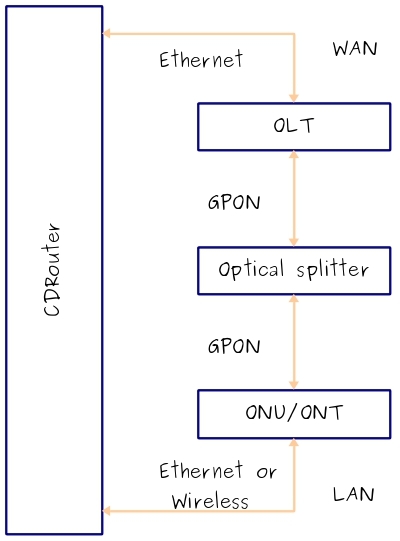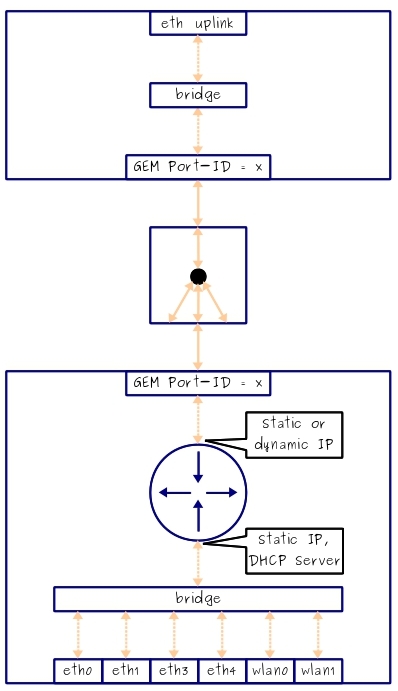Articles
GPON Testing With CDRouter
3 min read
Requirements
The core gateway functionality of a GPON ONT can be tested with any version of CDRouter or CDRouter Multiport. If the ONT supports TR-069, IPv6, IKE, or storage additional CDRouter add-ons may be required to fully test these features.
Overview
A GPON consists of three main components:
- An Optical Line Termination (OLT) device, which terminates the common (root) endpoint of the optical network. It typically provides ethernet uplinks to the internet (WAN).
- One or more Optical Network Termination (ONT) devices, or more generally Optical Network Units (ONU), which terminate any of the distributed (leaf) endpoints of the optical network. These typically have LAN ethernet ports, WiFi, and can also have POTS jacks, coax, and USB ports.
- The Optical Distribution Network (ODN), which is the physical fiber infrastructure connecting the OLT to the ONTs. It consists of a tree of fiber cables and one or more optical splitters.
Although CDRouter does not test the GPON protocol directly, it can be used to verify the behavior of GPON devices, treating the GPON as a single entity. Looking at a GPON from CDRouter’s point of view, there is still a single WAN (ethernet) connection and a single LAN (ethernet or wireless) connection, just as with a typical CPE test setup. The difference though, is that in this case the WAN connection is to the OLT ethernet uplink port, and the LAN connection is to a LAN port on the ONT.
Test Setup
Connect the OLT to the ONT via an optical splitter and fiber optic cables. The GPON specification (ITU-T G.984) allows for split ratios of up to 1:64 or even 1:128, but 1:32 or lower are more common. It is assumed that single-mode fiber is used throughout the ODN.
It’s important to make sure the OLT and ONT devices are configured properly. The ONT should be configured as a router. On the upstream (GPON) side, it should be configured with a static IP address or configured to dynamically accept an IP address from the internet, as a DHCP client, for example. On the downstream (ethernet) side, it should have a static IP address and be set up as a DHCP server for any devices connected to its LAN ports. The OLT should be set up to bridge between the ONT and its uplink ethernet port(s). CDRouter can now connect to an uplink ethernet port of the OLT as well as to an ethernet LAN port of the ONT and can execute tests as usual.
From CDRouter’s point of view, the entire GPON can be treated as a single entity as follows:

In order to get the OLT to bridge correctly, it may be necessary to configure an internal VLAN between the ethernet uplink port, and the logical GEM port of the ONT. (GEM refers to GPON Encapsulation Method, and is the native protocol used for transmitting data within a GPON.) Combined with the ONT, this internal configuration can be conceptualized as follow

If the GPON devices support IPv6 or TR-069, CDRouter will be able to test this functionality as well.
Caveats
Note that even if a single ONT is used, a passive optical splitter is still necessary in order to attenuate the optical signal. The splitter attenuates in both directions, not just downstream. Minimum attenuation values of 5 dBm, 10 dBm, or 15 dBm are required depending on whether ODN Class A, B, or C is used, respectively. Refer to Table 2 of ITU-T G.984.2 and the definition of ODN attentuation classes in Table 3 of ITU-T G.982. Class B+ is commonly used by vendors, which has a minimum attenuation of 13 dBm.
